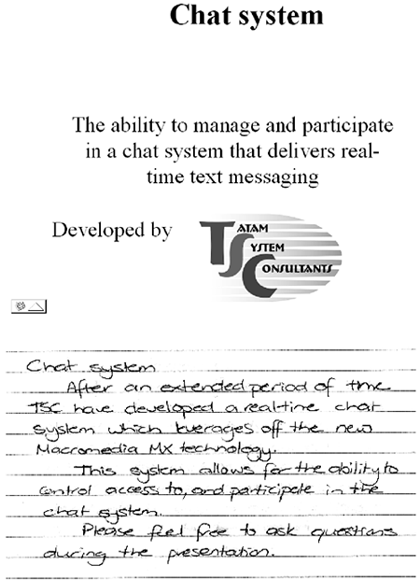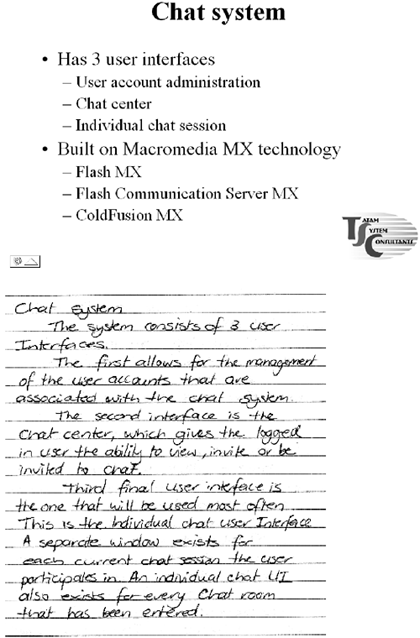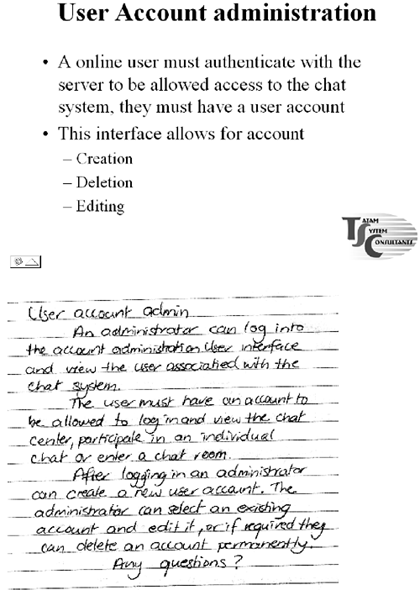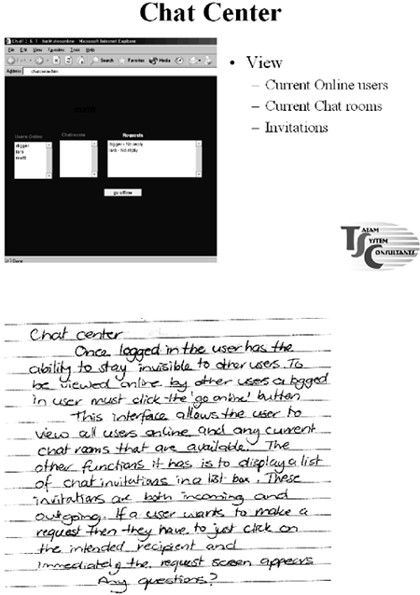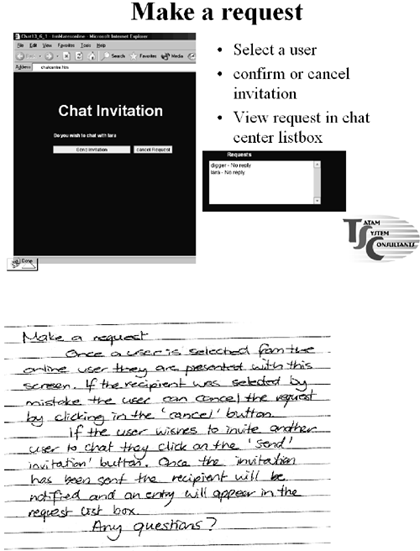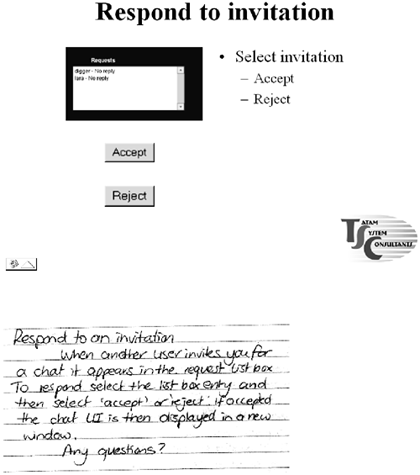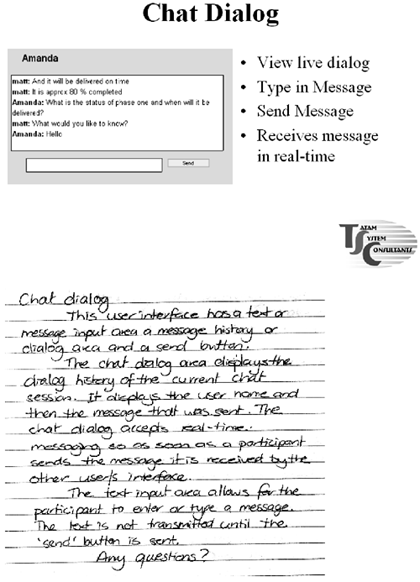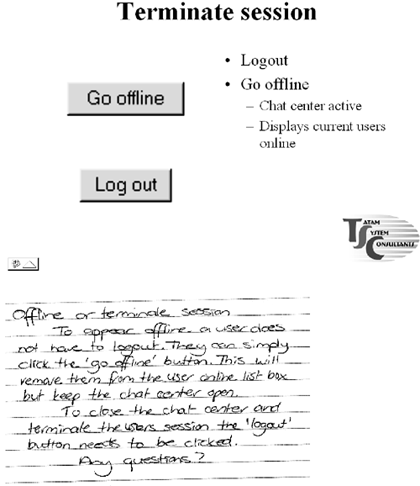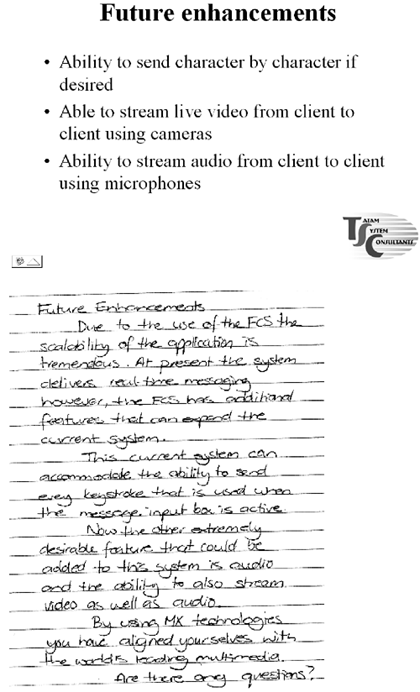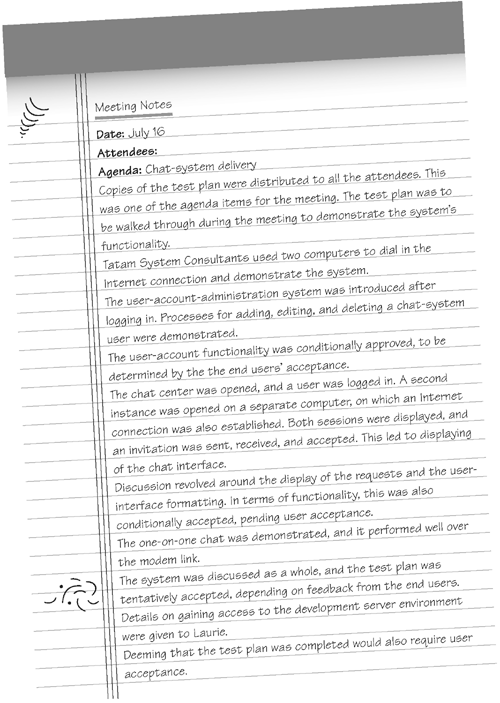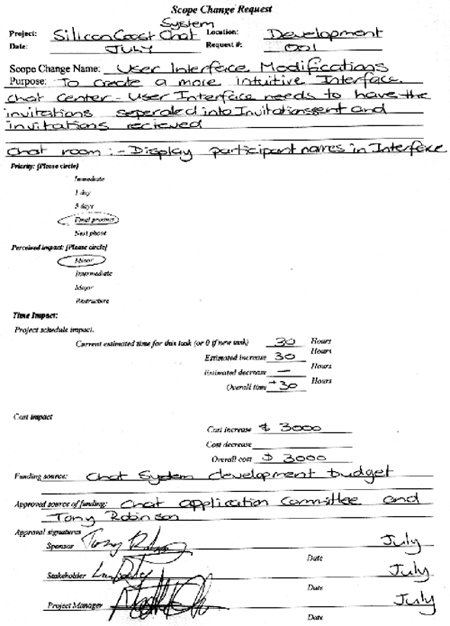Meeting with the Client
| An email was sent to the client to discuss the status of the current system.
A meeting was organized between Silicon Coast and TSC to present the newly created system. The meeting was a success; however, a few minor modifications were agreed upon. TSC's Matt Tatam opened the meeting by saying, "Everyone please be seated I'd like to walk you through your new chat system." The participants casually seated themselves. Everyone present were eager to view the system that would assist in the growth of their business. TSC used both a slide presentation and the actual development system to walk the client through the application. TSC finds it useful to employ both forms of media to communicate the functionality and features of the working system. The following are the individual slides used in the meeting and the handwritten notes that assisted the presenter throughout the talk. The first two slides present the overall new system in a general manner (Figure IV-4.1 and Figure IV-4.2). Opening with these two slides gave the audience an introduction to the system. The third slide discusses the user-account system and how it relates to the other components (Figure IV-4.3). Figure IV-4.1. The first slide delivers the system's objective.
Figure IV-4.2. The second slide displays the new system's technology and components.
Figure IV-4.3. The third slide shows the user-account-administration user interface.
The next four slides (Figures IV-4.4 through IV-4.7) describe the log-in process, chat center, and issuing of and responding to chat invitations. Figure IV-4.4. The login screen.
Figure IV-4.5. The fifth slide shows the chat-center user interface.
Figure IV-4.6. Making a request to chat.
Figure IV-4.7. Responding to a request.
The actual individual chat interface is illustrated in the eighth slide (Figure IV-4.8). This slide was the focal point of the presentation. This is the UI that is the core of the application's goal: to communicate in real-time text. The ninth slide discusses the ability to go offline or to log out of the system (Figure IV-4.9). Figure IV-4.8. The individual chat user interface.
Figure IV-4.9. Going offline or terminating a session.
The whole system had now been presented. The speaker opened discussion of the system's positives and negatives. Once these were discussed, the final slide was shown (Figure IV-4.10). It was used to convey the system's scalability, as well as additional features such as video and audio, that TSC could continue to develop. This slide was designed to seed the customer's thoughts on the next possible phase of the system. It also gave the impression that TSC would be more than happy to continue the relationship with WalkAbout by developing additional functionality. Figure IV-4.10. System's positives and negatives.
The client required a user-acceptance session to determine whether it would accept the system as presented or advise on changes that were desirable. Silicon Coast approached its usability testing very seriously. The initial testing was done by two people whose jobs were to identify the chat system's main usability issues. Shortly thereafter, all end users were exposed to the new system. The following are the Usability Testing Notes: Chat Center
Chat
User-Account Admin
All functionality appears to be covered. The group's completed test plan can be seen in Table IV-4.1.
Laurence's senior developer presented the test plan to him. The main points highlighted addressed the user interface. The system's functionality and overall performance were not in any way found unacceptable. The following email confirmed his company's conditional acceptance of the system.
Matt Tatam immediately forwarded the email to the developers. The email let them know that no major issues had arisen. Matt phoned Laurence to discuss the user interface changes. These were more cosmetic than functional. A scope change of request form was requested to be filled out and sent to Matt for approval. The changes of scope can be seen in Figure IV-4.11. Figure IV-4.11. Scope change request form.
It was agreed that if these changes were made, the test plan would be signed off on and approved. While the user-interface modifications were taking place, the final details on deployment were being defined. |
EAN: 2147483647
Pages: 114
- Enterprise Application Integration: New Solutions for a Solved Problem or a Challenging Research Field?
- Context Management of ERP Processes in Virtual Communities
- Intrinsic and Contextual Data Quality: The Effect of Media and Personal Involvement
- A Hybrid Clustering Technique to Improve Patient Data Quality
- Development of Interactive Web Sites to Enhance Police/Community Relations
- Chapter II Information Search on the Internet: A Causal Model
- Chapter VIII Personalization Systems and Their Deployment as Web Site Interface Design Decisions
- Chapter IX Extrinsic Plus Intrinsic Human Factors Influencing the Web Usage
- Chapter XV Customer Trust in Online Commerce
- Chapter XVI Turning Web Surfers into Loyal Customers: Cognitive Lock-In Through Interface Design and Web Site Usability

